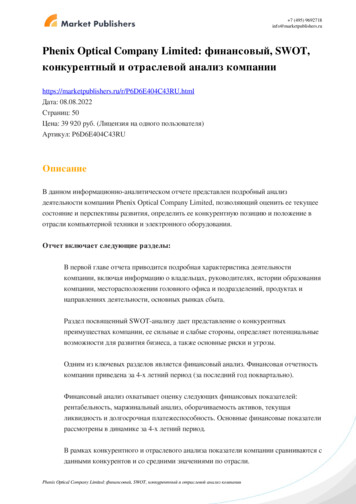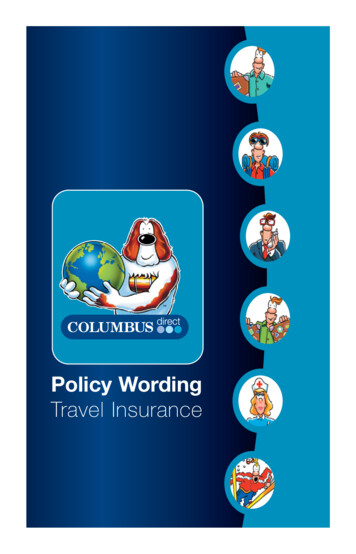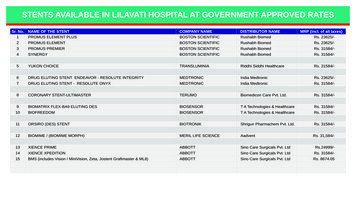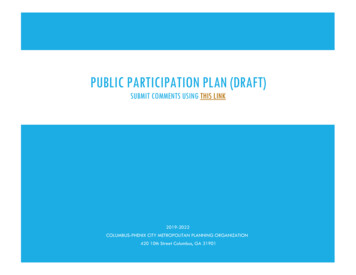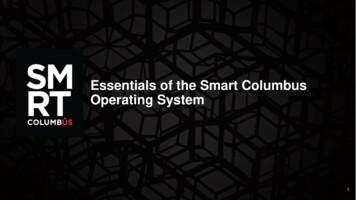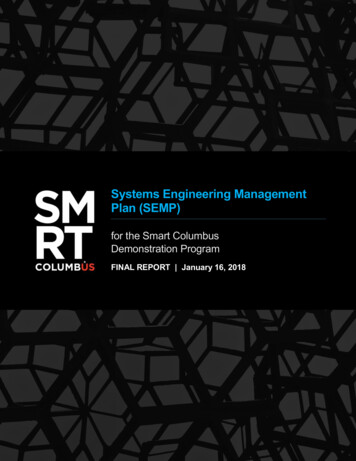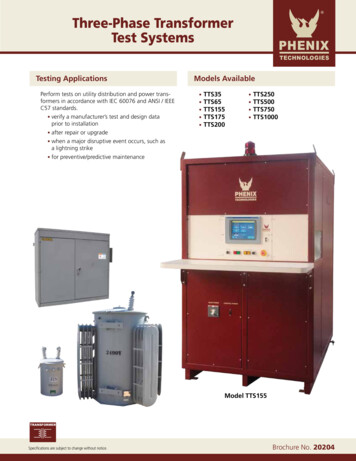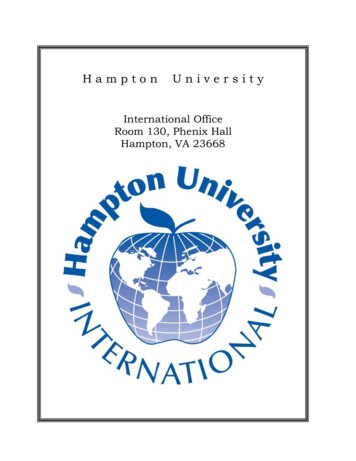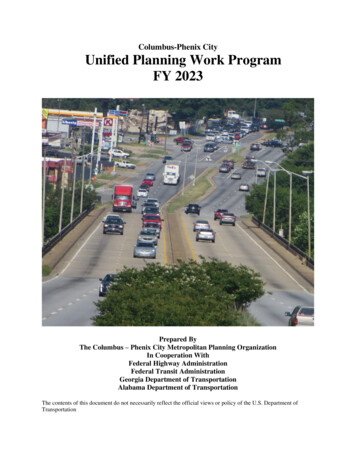
Transcription
Columbus-Phenix CityUnified Planning Work ProgramFY 2023Prepared ByThe Columbus – Phenix City Metropolitan Planning OrganizationIn Cooperation WithFederal Highway AdministrationFederal Transit AdministrationGeorgia Department of TransportationAlabama Department of TransportationThe contents of this document do not necessarily reflect the official views or policy of the U.S. Department ofTransportation
TABLE OF CONTENTSTitle Page and MPO Contact PageResolutionMPO MembershipMPO Boundary Map1235INTRODUCTIONOverview of the Transportation Planning ProcessPublic InvolvementMetropolitan Planning ProcessCommittee PoliciesEnvironmental Justice77789LAWS AND REGULATIONSFixing America’s Surface Transportation Act (FAST Act)11PERFORMANCE BASED PLANNING (GOALS AND OBJECTIVES)Planning FactorsMetropolitan Planning Factors to be Considered in the 2023 UPWPPlanning Emphasis Areas12171823 CFR 450.104 Subpart A – Transportation Planning & Programming Definition22FISCAL YEAR 2023 DRAFT UNIFIED PLANNING WORK PROGRAM231.0 ADMINISTRATIONTask 1.2 – Operations and AdministrationTask 1.3 – Training and Employee EducationTask 1.6 – Unified Planning Work Program (UPWP)Task 1.7 – Quarterly and Annual Reports for PL Funds24252627282.0 PUBLIC INVOLVEMENTTask 2.1 – Community Outreach and EducationTask 2.2 – Environmental Justice / Title VITask 2.3 – Public Participation Plan293031323.0 DATA COLLECTIONTask 3.1 – Socio-Economic DataTask 3.4 – Transportation Analysis, Models, and Surveys3334354.0 SYSTEM PLANNINGTask 4.1 – Congestion Management ProcessTask 4.4 – Air Quality Technical StudiesTask 4.5 – Bicycle – Pedestrian PlanningTask 4.7 – Geographic Information System Development3738394041
Task 4.11 – Metropolitan Transportation PlanTask 4.12 – Transportation Improvement Program42435.0 TRANSIT SERVICE PLANNINGTask 5.1 – Preparation and Administration of Transit GrantsTask 5.2 – Disadvantaged Business Enterprise (DBE) ProgramTask 5.3 – Transit Planning and Management Information SystemTask 5.4 – Training and Transit ConferencesTask 5.5 – Phenix City Transit Planning (LRCOG)454647485051TRANSIT SERVICE PLANNING – Georgia SectionSub-Element: 44.21.00 – Program Support and AdministrationSub-Element: 44.24.00 – Short Range Transportation PlanningSub-Element: 44.25.00 – Transportation Improvement Program (TIP) –Georgia Transit Section525355EXHIBIT 4 – SECTION 5303 BUDGET INFORMATION586.0 SAFE & ACCESSIBLE TRANSPORTATION OPTIONS (Y410)60FY 2023 SOURCE OF FUNDS61ALABAMA PLANNING STUDIES64APPENDIX65MPO COMMITTEE BYLAWSCOLUMBUS-PHENIX CITY TRANSPORTATION – MOU576679
COLUMBUS-PHENIX CITYMETROPOLITAN PLANNING ORGANIZATION (MPO)FY 2023UNIFIED PLANNING WORK PROGRAMView this document at http://www.columbusga.org/PlanningFor Information regarding this document, please contactLynda R. Temples, Principal Transportation PlannerColumbus-Phenix City Transportation Study420 10th Street, 2nd FloorP.O. Box 1340Columbus, Georgia 31902Telephone: 706-225-3938Email: ltemples@columbusga.orgDate adopted: March 15, 2022The Unified Planning Work Program (UPWP) was prepared as a cooperative effort of the U.S. Departmentof Transportation, Federal Highway Administration, Federal Transit Administration, the AlabamaDepartment of Transportation, the Georgia Department of Transportation, and local participatinggovernments, in partial fulfillment of requirements in Title 23 USC 134 and 135, amended by the FASTAct, Sections 1201 and 1202, December 2015. The contents of this document do not necessarily reflect theofficial views or policy of the U.S. Department of Transportation.The Columbus-Phenix City MPO complies with Title VI of the Civil Rights Act of 1964 (42 U.S.C. 2000det seq.), which states that “no person in the United States shall, on the ground of race, color, or nationalorigin, be excluded from participation in, be denied the benefits of, or be subjected to discrimination underany program or activity receiving Federal financial assistance.” In addition to Title VI, there are otherNondiscrimination statutes that afford legal protection. These statutes include the following: Section 162(a) of the Federal-Aid Highway Act of 1973 (23 USC 324) (sex), Age Discrimination Act of 1975 (age),and Section 504 of the Rehabilitation Act of 1973/Americans with Disabilities Act of 1990 (disability).1
METROPOLITAN PLANNING ORGANIZATIONCOMMITTEESPOLICY COMMITTEEVOTING:Mayor B.H. “Skip” Henderson, III, Columbus – ChairMayor Eddie Lowe, Phenix City – Vice-ChairVacant, Georgia State Transportation BoardMayor Fred Copeland, Jr., Smiths Station, AlabamaChance Corbitt, Chairman, Russell County (Alabama) CommissionBill English, Chairman, Lee County (Alabama) CommissionRosa Evans, Director of METRA, ColumbusSteve Graben, Southeast Regional Engineer, Alabama DOTDamon Hoyte, Chairman, Cusseta-Chattahoochee (Georgia) CommissionRick Jones, Director of Planning/MPOJannine Miller, Director of Planning, Georgia DOTVacant, Chairman, Citizens Advisory CommitteeLisa Sandt, Lee Russell County of Governments, PEXADVISORY: Mark D. Bartlett, PE, Division Administrator, FHWA, AlabamaBradley B. Lindsey, PE, State Local Transportation Engineer – Alabama DOTDaniel Hinton, PE, Acting Division Administrator, FHWA, GeorgiaMichael Presley, District Engineer, Georgia DOTRadney Simpson, Office of Planning, Georgia DOTTECHNICAL COORDINATING COMMITTEEVOTING:Rick Jones, Director of Planning, Columbus, ChairVacant, Master Planner, Fort BenningRamsey Ashmore, PE, Montgomery Area Traffic Engineer, Alabama DOTVance Beck, PE, Assistant Director of Engineering, ColumbusTom Bickel, Board of Commissioners, Chattahoochee CountyShawn Blakeney, PE, Russell County EngineerAmber Clark, Director, Columbus AirportFelton Grant, Transportation Planning ROW Coordinator, ColumbusJustin Hardee, PE, Lee County EngineerPam Hodge, Deputy City Manager, ColumbusWallace Hunter, City Manager, Phenix CityRobert B. Dees, PE, Planning Engineer, Local Transportation Bureau,ALDOTJim Livingston, Executive Director, River Valley Regional CommissionAngel Moore, City Engineer, Phenix CityEna Rivera, METRA, ColumbusKaniz Sathi, Transportation Planning Specialist, Georgia DOTAdam Smith, Pre-Construction Engineer, Georgia DOT3
ADVISORY: Larry Alexander, Federal Highway Administration, AlabamaCarol Comer, Multi-Modal Planning Division, Georgia DOTAnne Marie Day, Planning Team Leader, FHWA, GeorgiaJosh Kervin, PE, Southeast Region Pre-Construction Engineer, ALDOT OliviaLewis, Federal Highway Administration, GeorgiaVacant, Chairman, Citizens Advisory CommitteeHarland Smith, District Planning & Programming Coordinator, GDOT NicoleSpivey, Federal Transit Administration, GeorgiaTim Toomy, PE, Area Engineering, GDOTRhonda King, Program Analyst, FTA AlabamaCITIZENS ADVISORY COMMITTEEVOTING:CAC Committee is being restructuredADVISORY: Rick Jones, Director of Planning - Secretary4
5
INTRODUCTION6
A.OVERVIEW OF THE TRANSPORTATION PLANNING PROCESSAs the Metropolitan Planning Organization (MPO) for the Columbus-Phenix City Metropolitan Area,Columbus-Phenix City Transportation Study (C-PCTS) is the lead agency responsible for administeringand coordinating the activities of participants carrying out the required tasks of the transportation planningprocess. Participants in the transportation planning process include the C-PCTS, the Policy CoordinatingCommittee (PCC), the Citizen Advisory Committee (CAC), the Technical Coordinating Committee (TCC),public transit operators including METRA and PEX, counties, local officials, private citizens, and the U.S.Department of Transportation (U.S.DOT).B.PUBLIC INVOLVEMENTIn the FAST Act, the metropolitan and statewide transportation planning processes are continued andenhanced to incorporate performance goals, measures, and targets into the process of identifying neededtransportation improvements and project selection. Public involvement remains a hallmark of the planningprocess. Transportation planning must also comply with the Americans with Disabilities Act (ADA). MPOStaff along with Columbus’ Engineering Department will update the ADA Transition Plan as needed. Toprovide a framework through which the citizens of the community can participate in an advisory capacityin the planning and programming of transportation, citizen participation is required.The MPO will be cognizant of the needs of the public through the Citizens Advisory Committee(CAC) and the public at large by following these guidelines: There will be a 30-day comment period before planning documents are adopted. There will be a one-week notice given before public meetings to approve the TransportationPlan and the Transportation Improvement Program (TIP) using the Local Governmenttelevision channel, local newspaper ads, advertising, mailings and posted signs. A comprehensive public involvement document will be produced, which will be availableto the public along with all planning documents. Public involvement will be reviewed using various statistical evaluations.C.METROPOLITAN PLANNING PROCESSIn 1964, the State Governors of Georgia and Alabama appointed the Columbus Department of Planning asthe Metropolitan Planning Organization (MPO) for the Columbus-Phenix City Metropolitan Area. TheColumbus-Phenix City MPO is a Transportation Management Area (TMA) with a population of greaterthan 200,000 based on Census Information. Map 1 identifies the urban area served by the MPO.The Transportation Planning Division, which is located within the Department of Planning, serves as theplanning and technical staff for the MPO. The MPO carries out its work activities by utilizing threecommittees: the Citizens Advisory Committee (CAC), the Technical Coordinating Committee (TCC), andthe Policy Coordinating Committee (PCC). All transportation-planning activities identified in the UPWPaddress concerns and comments received from committee representatives during the documentdevelopment and review process to ensure that transportation planning accomplishes the goals andobjectives established for the area.7
The Alabama Highway Department was re-designated as the Alabama Department of Transportation(ALDOT) in 1993 to provide a balanced and coordinated multi-modal transportation program and systemfor the state. ALDOT is responsible for the development of the state transportation plan, and coordinatesstatewide rail, waterway, highway, bikeway and transit planning activities.The Georgia Department of Transportation (GDOT) was formed by legislature in 1973 to serve all of thecitizens of Georgia through the efficient design, construction and maintenance of the state’s transportationsystem. GDOT is organized into nine divisions: Administration, Local Grants, Engineering, Intermodal,Construction, Permits & Operations, P3/Program Delivery, Finance, and Planning.D.COMMITTEE POLICIESThe Policy Committee is at the top of the organization, provides policy guidelines, and approves the workof the other committees. The Technical Coordinating Committee provides technical support and guidelines.The Citizen Advisory Committee is an important link between citizens and the MPO.The Transportation Planning Division is the staff to the MPO committees. This Division collectsinformation, analyzes it, and presents it to all the committees. Outlined below are the functions of eachcommittee.The Policy Coordinating Committee (PCC) performs the following duties for transportation planning.1. Formulates goals and objectives for transportation planning in the Columbus-Phenix Cityurbanized area.2. Provides governmental support to planning programs and assures cooperation between differentoffices.3. Reviews, amends, and adopts transportation plans and programs.4. Evaluates progress towards implementation of projects and, if needed, reschedules priorities.5. Approves the Unified Planning Work Program.The Technical Coordinating Committee (TCC) is a committee of public and private sector transportationspecialists. This committee deals with the technical activities necessary in the transportation planningprocess.1. Collects, maintains, and analyzes data for transportation planning.2. Prepares transportation plan and advises the Policy Committee on changes in the plan andprograms.3. Evaluates transportation system improvements and recommends changes to decision makers inthe government.4. Prepares the Unified Planning Work Program and the Transportation Improvement Programwith the MPO staff.8
The Citizen Advisory Committee (CAC) is an important link for two-way communication between thecitizens and the transportation professionals. This committee conveys the needs of the citizens to theplanners and explains the plans and programs to the citizens. The Citizen Advisory Committee has thefollowing responsibilities.1. Reviews current year transportation improvements and recommends a Unified Planning WorkProgram for the next year.2. Makes transportation recommendations to the Policy Committee and the Technical CoordinatingCommittee.3. Review’s policy and procedure matters and make appropriate recommendations to the PolicyCommittee and the Technical Coordinating Committee.4. Assesses public opinion through opinion polls and interviews and conveys to the Policy and theTechnical Committees the needs of the public.E.ENVIRONMENTAL JUSTICERecent federal guidelines on environmental justice have focused attention on the need to incorporateenvironmental justice principals into transportation planning processes and products. In 1994, ExecutiveOrder 12898: Federal Actions to Address Environmental Justice (EJ) in Minority Populations and LowIncome Populations recognized that the impacts of federal programs and activities may raise questions offairness to affected groups. The Executive Order requires any agency receiving federal funding to:“conduct its programs, policies, and activities that substantially affect human health or theenvironment, in a manner that ensures that such programs, policies, and activities do not havethe effect of excluding persons (including populations) from participation in, denying persons(including populations) the benefits of, or subjecting persons (including populations) todiscrimination under such programs, policies, and activities, because of their race, color, ornational origin.”The Executive Order supports a longstanding policy to actively ensure nondiscrimination and avoidnegative environmental impacts in federally funded activities. Title VI of the Civil Rights Act of 1964prohibits discriminatory practices in programs receiving federal funds. The National Environmental PolicyAct (NEPA) requires the disclosure of the environmental effects of proposed federal actions thatsignificantly affect the quality of human health. The 1994 Executive Order on Environmental Justicereinforces and focuses these two laws by requiring the disclosure of the environmental benefits and burdensof federal actions on those groups protected under Title VI. In 1997, the U. S. Department of Transportationissued its DOT Order to Address Environmental Justice in Minority Populations and Low- IncomePopulations to summarize and expand upon the requirements of the Executive Order.According to the federal guidance, the groups that must be addressed as part of the environmental justiceinclude African Americans, Hispanics, Asian Americans, Native American Indians and persons whosehousehold income is at or below the U.S. poverty guidelines. The Fixing America’s Surface Transportation(FAST) Act, transportation bill also requires that statewide planning processes be consistent with Title VI.Executive Order 12898, Sec. 2-29
The Columbus-Phenix City MPO will comply with all requirements of Title VI programs, processes, andprocedures.The MPO completed the Title VI Plan in 2019 and the document will be updated it as fThe City of Columbus completed a Title VI Plan for the City in January 2022.METRA updated the Title VI Plan in 2019: https://www.columbusga.gov/pdfs/FTA-TitleVI.pdf10
FIXING AMERICA’S SURFACE TRANSPORTATION ACT (FAST Act)On December 4, 2015, President Barack Obama signed into law the Fixing America’s Surface Transportation Act, or“FAST Act”. It is the first law enacted in over ten years that provides long-term funding certainty for surfacetransportation, meaning States and local governments can move forward with critical transportation projects. TheFAST Act largely maintains current program structures and funding shares between highways and transit. It is a downpayment for building a 21st century transportation system, increasing funding by 11 percent over five years. The lawalso makes changes and reforms to many Federal transportation programs, including streamlining the approvalprocesses for new transportation projects, providing new safety tools, and establishing new programs to advancecritical freight projects. The FAST Act provisions are outlined below:PROJECT DELIVERY: The FAST Act adopted a number of Administration proposals to further speed thepermitting processes while still projecting environmental and historic treasures and codifying the online system totrack projects and interagency coordination processes.FREIGHT: The FAST Act would establish both formula and discretionary grant programs to fund criticaltransportation projects that would benefit freight movement. The Act emphasizes the importance of Federalcoordination to focus local governments on the needs of freight transportation providers.INNOVATIVE FINANCE BUREAU: The FAST Act establishes a new National Surface Transportation andInnovative Finance Bureau within the Department to serve as a one-stop shop for state and local governments toreceive federal funding, financing or technical assistance. This builds on the work of the Department’s Build AmericaTransportation Investment Center and provides additional tools to improve coordination across the Department topromote innovative finance mechanisms. The Bureau is also tasked with the responsibility to drive efficiency in thepermitting process.TIFIA: The TIFIA Loan program provides important financing options for large projects and public-privatepartnerships. The FAST Act includes organizational changes that will provide an opportunity for important structuralimprovements with the potential to accelerate the delivery of innovative finance projects.SAFETY: The FAST Act includes authority sought by the Administration to prohibit rental car companies fromknowingly renting vehicles that are subject to safety recalls. It also increased maximum fines against non-compliantauto manufactures from 35 million to 105 million. The law also will help bolster the Department’s safety oversightof transit agencies and streamlines the Federal truck and bus safety grant programs, giving more flexibility to Statesto improve safety in these areas.TRANSIT: The FAST Act includes a number of positive provisions, including reinstating the popular busdiscretionary grant program and strengthening the Buy America requirements that promote domestic manufacturingthrough vehicle and truck purchases.LADDERS OF OPPORTUNITY: The FAST Act includes a number of items that strengthens workforce trainingand improve regional planning. Notably, FAST Act makes Transit Oriented Development (TOD) expenses eligiblefor funding under highway and rail credit programs. TOD promotes dense commercial and residential developmentnear transit hubs in an effort to shore up transit ridership and promote walk-able, sustainable land use.11
Planning FactorsThe MPO develops the UPWP to provide comprehensive, cooperative and continuing transportationplanning (known as the “3-C Process”) for the Columbus-Phenix City area. The FAST Act requires that themetropolitan planning process consider and analyze the following ten factors for each planning activity.The ten planning activity factors with C-PCTS’s associated goals and objectives are shown below and areintegrated into the UPWP task elements.1. Support the economic vitality of the metropolitan area, especially by enabling global competitiveness,productivity, and efficiency while promoting consistency among transportation improvements and stateand local planning growth and economic development patterns.Goal: A globally competitive, diversified economy that protects and enhances our naturalenvironment:Metrics: Number of demolished structures during construction of transportation projects. TIAProject – Intersection Improvements along Buena Vista Road (Columbus Spider WebNetwork) – During the ROW phase, ten (10) structures were demolished. One (1), maybetwo (2) structures to be demolished once the ROW phase is completed. Acres of agricultural land or vacant properties converted to another use. 272.65 acres ofvacant properties that were converted to another use. Number of rezoning cases that negatively affect the transportation network. Staff completedthirty-four (34) traffic analysis for the rezoning cases with one (1) case that will affect thetransportation network. Objective 1: Emphasize public/private partnership resulting in increased regionalinvestment. Objective 2: Accentuate the utilization and expansion of our existing transportationand infrastructure advantages. Objective 3: Promote growth that protects and enhances the environment.2. Increase the safety of the transportation system for motorized and non-motorized users. On January 19,2021, the Columbus-Phenix City Transportation Study (C-PCTS) MPO Policy Committee adopted theGeorgia Department of Transportation (GDOT) Safety Performance Management Targets for 2021. OnOctober 20, 2020, the Columbus-Phenix City Transportation Study (C-PCTS) MPO Policy Committeeadopted the Alabama Department of Transportation (ALDOT) Safety Performance management Targetsfor 2021. The Safety Targets are adopted on a yearly basis.Goal: A safe transportation system:Metrics: Number of automobile collisions per year - (January 1, 2020 to December 1, 2021Georgia) – 11,505 with 26 fatalities. Data received from GEARS, Columbus PoliceDepartment. Number of bike fatalities per year – (2021 Georgia) – 41 bicycle crashes with two (2)fatalities. Data received from GEARS & the Columbus Police Department. Number of pedestrian fatalities per year. January 1, 2020 to December 1, 2021 (Georgia)– 17 fatalities. Data received from GEARS & the Columbus Police Department. There isno data available for Harris County as they have a disclaimer on their website: “Pleasenote that the 2020 Data is incomplete for some agencies and therefore is notrecommended to be including for crash analysis”. Objective 1: Locate the top five (5) most dangerous intersections. MPO Staffcontinues to work with the Law Enforcement Offices and the EngineeringDepartments of the counties/cities within the MPO region to locate the top five12
most dangerous intersections. Funding to improve these intersections can be MPOor local funds. Objective 2: Continue to educate drivers and bicyclists-pedestrians about safelysharing the road. Objective 3: MPO Staff will work with the Transit agencies on incorporatingincident data for Safety Planning3. Increase the security of the transportation system for motorized and non-motorized users.Goal: A secure transportation system:Metrics: Improve the safety of transit facilities including stops and vehicles. METRA currently hascameras on all buses and is currently discussing ways to improve security on the busstops. METRA will utilize FTA 5307 funding to add amenities along METRA’s 10 fixedbus routes. These amenities will include new benches, shelters, concrete slabs undershelters, and trash receptacles. Future improvements will include lightening installedaround the bus stops/shelters. Support the development of regional preparedness and evacuation planning.4. Increase the accessibility and mobility of people and for freight. Add Freight Plan and update ofCMPGoal: An accessible transportation system:Metrics: Dial-A-Ride ridership per year. METRA transports 60,000 riders annually (about 200 perday). Average Truck Speed on the National Highway System. Objective 1: Strive to integrate local, regional, and national transportation systemsto facilitate movement of people and freight between modes. The MPO’s Citizen’sAdvisory Committee has a member from the Freight Community to help the MPOwith the needs of the freight community. MPO will conduct a Freight Plan andupdate the Congestion Management Process during FY 22 / FY 23. Objective 2: Support Freight facilities connecting the region to national and globalmarkets. MPO Staff will conduct a Freight Plan Study during FY 22 / FY 23. Staffwill incorporate projects identified in the 2019/2020 J.R. Allen Parkway / US 80Corridor Study. This corridor is a main thoroughfare for freight (Truck) trafficthat travels through Columbus from east Georgia to surrounding cities/countieswithin the MPO region. Objective 3: Enhance connectivity between housing, jobs, services, andeducational facilities. Objective 4: Continue to improve system accessibility for people with specialtransportation needs, including persons with disabilities, the elderly, and the youngand low-income populations. Increase ADA compliance with intersectionimprovements. MPO Staff continues to work with the Cities of Columbus (Georgia)and Phenix City (Alabama) on implementing projects identified in the ADACompliance Documents for each city. Phenix City completed a ADA complianceproject along 14th Street between Broad Street and 5th Avenue. Objective 5: Encourage land use policy that supports access for disabled persons,efficient mass transit, and non-motorized travel. Objective 6: Number of projects that comply with Complete Streets. (A completestreet is a safe, accessible, and convenient street for all users regardless oftransportation mode, age, or physical ability. Complete streets adequately providefor bicyclists, pedestrians, transit riders, and motorists. Complete streets promote13
healthy communities and reductions in traffic congestion by offering viablealternatives to driving). The MPO and City staff continue to work with theconsulting firms designing the Buena Vista Road Spider Web, and the Cusseta /Old Cusseta Road, and the Buena Vista Road Interchange TIA projects andInfantry Road-Follow Me Trail Extension, Military Drive, South Lumpkin RoadStreetscape, Whitesville Road Widening, Cusseta Road Widening projects that willinclude the Complete Streets policy.5. Protect and enhance the environment, promote energy conservation, improve quality of life, andpromote consistency between transportation improvements and State and Local planned growthand economic development patterns.Goal: A sustainable transportation system:Metrics: Percentage of workers commuting by bus Percentage of workers commuting by bicycle Percentage of workers commuting by walking Objective 1: Continue to collect data on bicyclists using mobile app and compilingdata into annual report. MPO Staff will utilize the Safety Targets to educatecommuters on safety measures. Objective 2: Create inventory of bike lane mileages and types as a shape file.Please clink on this link for updated bike lanes / multi-use trails.http://arcgis/115XvW Objective 3: Update inventory of sidewalk mileage and type as shape file. MPOstaff is working on producing an inventory of sidewalks in Columbus and PhenixCity. The MPO included a study in the 2045 MTP to complete a sidewalk studythroughout the MPO urbanized area. Objective 4: Continue to add bicycle-pedestrian infrastructure to the network.MPO Staff continues to work with the City of Columbus on implementing projectsidentified in the MPO’s Alternative Transportation Plan. Listed in the 2045 MTPare a few of these projects.6. Enhance the integration and connectivity of the transportation system, across and between modes,for people and freight.Goal: An integrated transportation system:Metrics: Survey count of Park and Ride users. MPO Staff continues to work with the transitagencies to promote the use of Park and Ride locations. Percentage of workers commuting by bus. Percentage of workers commuting from other counties. Objective 1: Reduce congestion on major freight and passenger routes. MPO Staffis working with GDOT on the US 80 / Beaver Run corridor on traffic signalupgrades and two roundabouts to increase travel time and reduce wait time at thetraffic signals. MPO Staff is working with the Engineering Department for the Cityof Columbus on improving the intersection of 17th Street/Linwood Blvd/13thAvenue. MPO Z230 Funds will be used to construct a Roundabout at this location. Objective 2: Improve the internal connectivity of the transportation network. Objective 3: Increase access, expansion and improve the reliability of public masstransit.14
7. Promote efficient system management and operation.Goal: An efficient transportation system:Metrics: Level of Travel Time Reliability (LTTR) Peak Hour Travel Time Ratio (PHTR) Truck Travel Time Reliability (TTTR) Objective 1: June 19, 2018, the Columbus-Phenix City Transportation Study (CPCTS) MPO Policy Committee adopted the Georgia Department ofTransportation (GDOT) Travel Time Targets and on August 21, 2018, the MPOPolicy Committee adopted the Alabama Department of Transportation (ALDOT)Travel Time Targets for 2018.8. Emphasize the preservation of the existing transportation system.Goal: Maximize transportation system:Metrics: Number of rezoning cases (changes in land use) that do not have a negative impact on thetransportation system. Staff completed thirty-four (34) traffic analysis for the rezoningcases with one (1) case that effect the transportation network. Number of completed projects that increase capacity without widening the road. Objective 1: Promote projects that increase capacity and safety without wideningthe road. The Buena Vista Road Diverging Diamond Interchange (TIA) projectwill increase capacity and safety wi
The Columbus-Phenix City MPO complies with Title VI of the Civil Rights Act of 1964 (42 U.S.C. 2000d et seq.), which states that "no person in the United States shall, on the ground of race, color, or national origin, be excluded from participation in, be denied the benefits of, or be subjected to discrimination under
